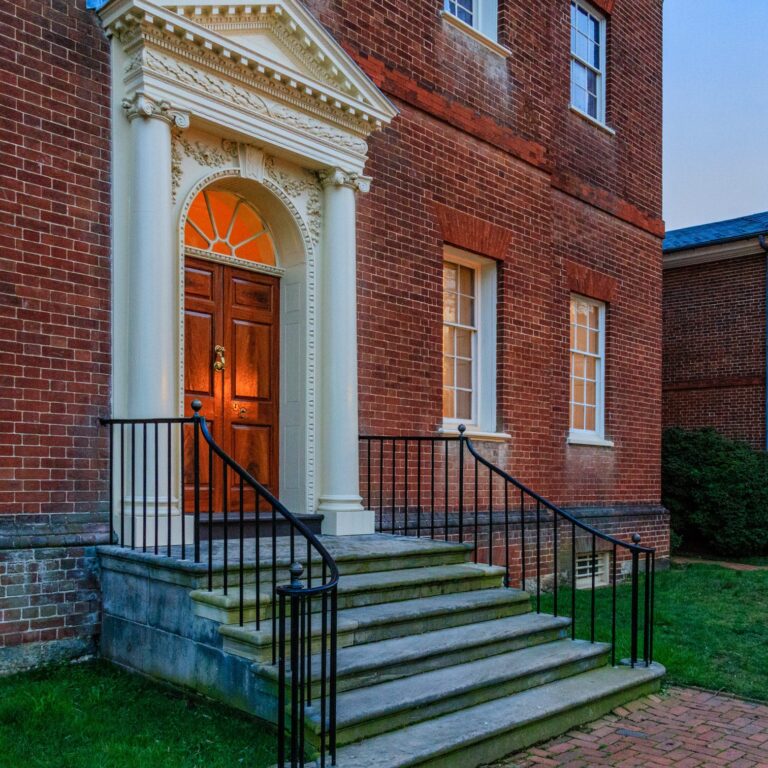
Hammond-Harwood House
19 Maryland Ave.
Annapolis, MD 21401
(410) 263-4683

19 Maryland Ave.
Annapolis, MD 21401
(410) 263-4683
The Hammond-Harwood House is a museum of early American architecture and art standing as a testament to the importance of preservation to the residents of Annapolis, and America. Built in 1774, this National Historic Landmark presents a window into the lives of the people who built the house, lived in it, and ensured that it would be enjoyed by future generations for years to come. Tours of the House highlight its refined design, unique history, and incomparable collection of paintings by Charles Willson Peale and furniture by John Shaw.
Tours of the museum highlight architecture, social history, and the collection of paintings by Charles Willson Peale and furniture by John Shaw.
Open for tours – reservations suggested. Noon to 5:00 p.m (last tour at 4:00 p.m). Closed Tuesdays.
Virtual Experiences:
On the Hammond-Harwood House Facebook page, docents share some of their favorite pieces of art, architecture, and the fine examples of craftsmanship exhibited in the house.
The Hammond-Harwood House blog on the website features an “object of the week” —all about a painting, furniture piece, silver teapot, kitchen implement— as well as social history pieces on the enslaved and the family who lived in the house. The schedule for virtual lectures and programs can be found on the site.
Dottie Byerly is a volunteer at the Hammond-Harwood House, a historic site in downtown Annapolis where her mom happened to be raised as a baby.
Grades 6 to 8
A Day in the Life of a Great House program is designed for children in grades 6 through 8. This ninety-minute tour will take them through a day in the life of Frances Loockerman, who occupied the Hammond-Harwood House with her family beginning in 1811. Students will be introduced to Frances and Richard Loockerman by viewing their miniature portraits in the entry-way to the house.
The day will begin in the kitchen of the Hammond-Harwood House where we will hear about three enslaved people who served the Loockermans: Mary Matthews, Matilda Matthews, and Juliet. While the servants prepare for the day, the students will adjourn to the classroom or “breakfast” room.
Students will learn how to set a table for breakfast as the servants would have done. Then, the students, playing the roles of Richard and Frances’ children, will learn proper behavior at the table, including “not talking when the mouth is full” and “not making unpleasant sounds” while eating.
After “breakfast” we will then go into the garden and be introduced to the boxwood that Frances planted in the shape of a heart in 1825. As we walk around, we will see where the stables, orchard, vegetable garden, spring house, and outhouse used to be. A visit to the herb garden will show students popular herbs of the day and their uses. Finally, students will play period games including “London Bridge is Falling Down.”
Back in the house the students will go to the Northeast Bed Chamber where Frances would spend many hours reading, sewing, and writing letters. They will listen to one letter that Frances wrote to her daughter Hester in 1845.
Finally, they will visit the Ballroom where Frances and Richard spent time entertaining guests with music and dance. Some students will play the role of the Loockerman children practicing the violin and the piano forte. All students will participate in the Grand March, a dance movement that was popular during the early 19th century.
High School Program
Primary sources provide unique evidence about a person, an object, an event, or a work of art. In this ninety-minute session, high school students will examine the life of William Buckland, architect of the Hammond-Harwood House. They will look at mathematical tools which he may have owned, a portrait of William Buckland in the dining room, and the architectural details of the house. Much of Buckland’s life remains a mystery, including where he died and his burial site. However, the primary sources used in the program will help students learn more about the man who has been called one of the great colonial architects. Even Thomas Jefferson admired Buckland’s work on the Hammond-Harwood House and wanted to incorporate the semi-octagonal bays of the wings into his home at Monticello. Finally, students will have an opportunity to paint an outline of the front door on watercolor paper.